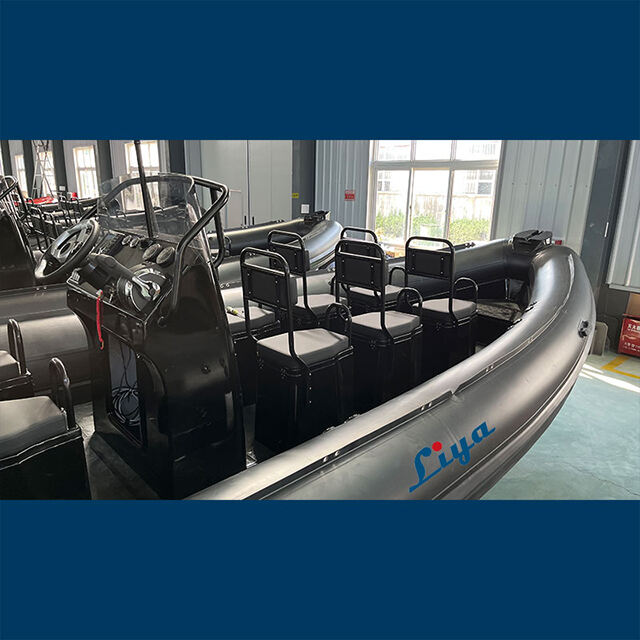Understanding the Power and Versatility of Modern Maritime Rescue Vessels
When lives are on the line in maritime emergencies, rescue teams worldwide consistently turn to RHIB boats as their vessel of choice. These Rigid Hull Inflatable Boats represent the perfect fusion of durability, speed, and maneuverability, making them invaluable assets in critical rescue operations. From their robust construction to their remarkable adaptability in various weather conditions, RHIB boats have proven themselves time and again as the most reliable platform for maritime rescue missions.
The exceptional capabilities of RHIB boats stem from their unique design, combining a solid hull with inflatable tubes that provide superior stability and buoyancy. This innovative structure allows these vessels to operate effectively in challenging conditions while maintaining the agility needed for precise rescue maneuvers. As we explore the various aspects of RHIB boats, we'll discover why they've become indispensable in maritime rescue operations across the globe.
Design Features That Set RHIB Boats Apart
Advanced Hull Construction
The foundation of every RHIB boat lies in its sophisticated hull design. Constructed from marine-grade aluminum or fiberglass, these hulls provide exceptional strength while maintaining relatively light weight. The deep-V shape allows for superior wave penetration, reducing impact and ensuring smoother navigation through rough waters. This design element is crucial during rescue operations where speed and stability are paramount.
Modern RHIB boats incorporate advanced hull technologies that enhance their performance in various sea conditions. The carefully engineered strakes and chines help channel water flow efficiently, improving both speed and fuel economy. These design features also contribute to the vessel's exceptional stability, allowing rescue teams to operate with confidence even in challenging maritime environments.
Inflatable Collar System
The distinctive inflatable tubes that line the gunwales of RHIB boats serve multiple critical functions. These high-strength, multi-chambered collars provide additional buoyancy and stability, acting as both a safety feature and performance enhancer. The tubes are manufactured from heavy-duty materials like Hypalon or polyurethane, ensuring durability and resistance to UV radiation, fuel, and harsh marine conditions.
During rescue operations, these inflatable collars prove invaluable as they act as protective bumpers when approaching other vessels or structures. They also provide additional flotation capacity, crucial when taking on rescued personnel. The segmented design ensures that even if one chamber is damaged, the overall integrity and functionality of the RHIB boat remain intact.

Performance Characteristics in Rescue Operations
Speed and Maneuverability
RHIB boats excel in rapid response scenarios, capable of achieving impressive speeds while maintaining exceptional handling characteristics. Their lightweight construction and powerful propulsion systems enable quick acceleration and high top speeds, crucial factors when racing against time in emergency situations. The combination of a rigid hull and inflatable tubes allows these vessels to execute tight turns and precise maneuvers without compromising stability.
The superior maneuverability of RHIB boats is particularly evident in challenging sea conditions. Their design allows them to navigate through rough waters while maintaining control and stability, enabling rescue teams to reach victims quickly and safely. This agility proves invaluable when operating in confined spaces or around obstacles, situations commonly encountered during rescue missions.
Stability and Safety Features
The inherent stability of RHIB boats is one of their most valuable attributes in rescue operations. The combination of a low center of gravity and the buoyant inflatable tubes creates a remarkably stable platform, even in adverse conditions. This stability is crucial when transferring rescued individuals from the water or other vessels, ensuring the safety of both rescuers and victims.
Modern RHIB boats incorporate numerous safety features designed specifically for rescue operations. These include non-slip decking, multiple grab handles, and reinforced lifting points. Advanced navigation and communication equipment ensure these vessels can operate effectively in all weather conditions and maintain constant contact with rescue coordination centers.
Versatility in Different Maritime Environments
Coastal and Harbor Operations
In coastal waters and harbor environments, RHIB boats demonstrate remarkable versatility. Their shallow draft allows them to operate in areas inaccessible to larger vessels, while their robust construction enables them to handle the dynamic conditions often found in these zones. Whether responding to incidents near shorelines or conducting searches in harbor areas, these vessels prove consistently reliable.
The ability to quickly deploy and recover RHIB boats makes them ideal for harbor rescue operations. Their compact size and maneuverability enable them to navigate through crowded marina areas and access tight spaces between moored vessels. This versatility is particularly valuable during emergency responses in busy port environments.
Offshore and Deep-Sea Capabilities
Despite their relatively compact size, RHIB boats demonstrate impressive capabilities in offshore environments. Their seaworthiness and range allow them to operate effectively far from shore, making them valuable assets for deep-sea rescue missions. Modern RHIB boats can be equipped with extended fuel capacity and advanced navigation systems for prolonged offshore operations.
The design of RHIB boats enables them to handle challenging ocean conditions while maintaining operational effectiveness. Their ability to operate in high seas and strong winds makes them reliable platforms for offshore rescue operations, whether working independently or in conjunction with larger vessels and aircraft.
Technological Advancements and Future Developments
Modern Navigation and Communication Systems
Contemporary RHIB boats benefit from cutting-edge navigation and communication technologies. Advanced GPS systems, radar equipment, and thermal imaging cameras enhance their operational capabilities in all conditions. These technological integrations enable rescue teams to operate effectively during nighttime operations and in poor visibility conditions.
The implementation of sophisticated communication systems ensures seamless coordination during rescue operations. Modern RHIB boats can be equipped with multiple radio systems, satellite communications, and real-time data sharing capabilities, enabling effective coordination with other rescue assets and command centers.
Emerging Technologies and Innovations
The future of RHIB boats looks promising with ongoing technological developments. Innovations in materials science are leading to stronger, lighter hull constructions and more durable inflatable components. Electric and hybrid propulsion systems are being developed, promising reduced environmental impact without compromising performance.
Autonomous systems and advanced sensor technologies are beginning to find their way into RHIB boat designs, offering potential enhancements to search and rescue capabilities. These developments suggest an exciting future where RHIB boats become even more effective and versatile in their rescue mission roles.
Frequently Asked Questions
What makes RHIB boats particularly suitable for rescue missions?
RHIB boats combine exceptional speed, stability, and maneuverability with robust construction and safety features. Their unique design, incorporating a rigid hull with inflatable tubes, provides optimal performance in various sea conditions while ensuring the safety of both rescuers and rescued individuals.
How do RHIB boats perform in extreme weather conditions?
RHIB boats are designed to operate effectively in challenging weather conditions. Their deep-V hull design, combined with the stabilizing effect of the inflatable tubes, allows them to maintain stability and maneuverability even in rough seas. Advanced construction materials and safety features further enhance their capability to operate in extreme conditions.
What is the typical operational range of a RHIB boat?
The operational range of RHIB boats varies depending on their size and configuration. Modern RHIB boats can be equipped with extended fuel capacity and typically achieve ranges between 100 and 300 nautical miles. Some specialized models designed for offshore operations can achieve even greater ranges with additional fuel storage.

